How Can Ski Resorts Get Smart? Transdisciplinary Approaches to Sustainable Winter Tourism in the European Alps
Abstract
1. Introduction
1.1. Study Areas
1.2. Alpine Resorts: Different Models
1.3. From Smart Cities to Smart Altitudes
1.4. Climate Change and Winter Tourism
2. Materials and Methods
2.1. Energy Audits: Identifying Opportunities to Save Energy
2.2. WebGIS: Bringing Together Data on Renewable Energy Potential and Energy Performance
2.3. Living Labs: Enabling Collaborative Learning
3. Results and Discussion
- Designed a structured questionnaire, interviewed ski resort managers, and carried out energy audits in the study areas, to systematically identify energy consumption patterns and opportunities to save energy (or to systematically identify the ecologic, energetic, and management patterns);
- Developed an open-source web-based GIS to bring together and visualize existing data on renewable energy potential as well as Smart Altitude KPIs on eco-energy-management efficiency in ski resorts, enabling users to calculate their own indicators and compare their destination with other municipalities of the Alpine Space Programme’s area; and
- Implemented real-world laboratories for transdisciplinary collaborative learning, so-called “living labs”, including stakeholders from research institutes, the tourism industry, local and/or regional governmental institutions, and local communities—thus following the quadruple helix model of innovation.
3.1. The Wi-EMT Audit Tool
3.2. The Smart Altitude WebGIS
3.3. Living Labs
3.3.1. Study Area 1: Les Orres, France
3.3.2. Study Area 2: Madonna di Campiglio, Italy
- Weather: Monitoring of temperature, precipitation, and solar radiation (with photovoltaic potential estimate), and forecasting of weather conditions;
- Skier data: Data on the skier days;
- Ski lifts: Data on energy consumption and number of entrances;
- Snow production: Data on water and compressed air usage, snow production, and energy consumption;
- Snow grooming: Data on operation, diesel consumption, snow-depth, and warehouses heating;
- Electric grid: Data on energy consumption from the medium voltage grid;
- Lake monitoring (Lake Montagnoli): Data on water temperatures at different depths and water surface level.
3.3.3. Study Area 3: Krvavec, Slovenia
3.3.4. Study Area 4: Verbier, Switzerland
3.4. Decision-Making Toolkit
4. Conclusions
Author Contributions
Funding
Acknowledgments
Conflicts of Interest
References
- Borsdorf, A.; Haller, A. Urban montology: Mountain cities as transdisciplinary research object. In The Elgar Companion to Geography, Transdisciplinarity and Sustainability; Sarmiento, F., Frolich, L., Eds.; Edward Elgar: Cheltenham, UK, 2020; pp. 140–154. ISBN 9781786430090. [Google Scholar] [CrossRef]
- Les Orres Municipality. Présentation de la Commune des Orres. Available online: https://web.archive.org/web/20200506093651/http://www.mairie-lesorres.fr/presentation-commune-orres (accessed on 6 May 2020).
- Province of Trento. ISPAT Annuario On-Line. Available online: https://web.archive.org/web/20200508142350/http://www.statweb.provincia.tn.it/movTuristico/data.asp?db=annuarioturismo&sp=spArrPresEsAlbXAmbProvMes&a=2018 (accessed on 8 May 2020).
- Pintar, M.; Mali, B.; Kraigher, H. The impact of ski slopes management on Krvavec ski resort (Slovenia) on hydrological functions of soils. Biologia 2009, 64, 639–642. [Google Scholar] [CrossRef]
- Téléverbier SA. Historique de L’entreprise. Available online: https://web.archive.org/web/20200508142551/http://www.televerbier.ch/fr/televerbier/presentation-de-la-societe/historique/historique.html (accessed on 8 May 2020).
- Vanat, L. Bilan De La Saison 2018/19, Fréquentation Des Domaines Skiables; Remontées mécaniques Suisses: Bern, Switzerland, 2019; Available online: https://web.archive.org/web/20200508142809/https://vanat.ch/RM-CH-palmares-JS2019-R-F-Laurent%20Vanat.pdf (accessed on 8 May 2020).
- Kaufmann, V.; Munafò, S. Vers Une Mobilité Plus Durable à Verbier, Etat Des Lieux Et Pistes D’améliorations; Laboratoire de Sociologie Urbaine (LaSUR): Lausanne, Switzerland, 2010; Available online: https://web.archive.org/web/20200508143333/https://documents.epfl.ch/groups/c/ch/chaire-landolt-et-cie/www/Verbier/2010%20GPS%20Rapport%20Verbier-fr.pdf (accessed on 8 May 2020).
- Office Fédéral De La Statistique, Section Tourisme. Hébergement Touristique, Hôtel, Commune. Available online: https://web.archive.org/web/20200508143751/https://www.bfs.admin.ch/bfs/fr/home/statistiques/tourisme/hebergement-touristique/hotellerie/communes.html (accessed on 8 May 2020).
- Smart Altitude Project. Wi-EMT Evaluation Report For Living Labs Les Orres, Madonna di Campiglio, and Krvavec. 2019; unpublished data. [Google Scholar]
- Smart Altitude Project. Characteristics of Smart Altitude Study Area Verbier, Personal Communication. 2020. [Google Scholar]
- Televerbier SA. Communiqué Résultat Du Premier Semestre 2018–2019, Press Release. Available online: http://web.archive.org/web/20200703123444/http://www.publicnow.com/view/5DEB1D33A297752968B812DD46F7E65302BBB44F (accessed on 7 March 2020).
- Camanni, E. Storia Delle Alpi: Le Più Belle Montagne Del Mondo Raccontate; Edizioni Biblioteca Dell’immagine: Pordenone, Italy, 2017; ISBN 9788863912692. [Google Scholar]
- Barker, M. Traditional landscape and mass tourism in the Alps. Geogr. Rev. 1982, 72, 395–415. [Google Scholar] [CrossRef]
- Bätzing, W. Die Alpen: Geschichte und Zukunft Einer Europäischen Kulturlandschaft, 4th ed.; C.H.Beck: Munich, Germany, 2015; ISBN 9783406681837. [Google Scholar] [CrossRef]
- Lichtenberger, E. The Eastern Alps, Problem Regions of Europe; Oxford University Press: Oxford, UK, 1975; ISBN 0199131066. [Google Scholar]
- Ferrero, G. Seconde case, politiche urbanistiche e turismo nelle Alpi occidentali italiane. Rev. Géograph. Alp. 1998, 86, 61–68. [Google Scholar] [CrossRef]
- Gosar, A. International tourism and its impact on the Slovenian society and landscape. GeoJournal 1993, 30, 339–348. [Google Scholar] [CrossRef]
- OECD. Slovenia, in OECD Tourism Trends and Policies 2016; OECD Publishing: Paris, France, 2016. [Google Scholar] [CrossRef]
- Vanat, L. International Report On Snow & Mountain Tourism-Overview of The Key Industry Figures For Ski Resorts; Geneva, Switzerland, 2020; Available online: http://web.archive.org/web/20200511133604/https://www.vanat.ch/RM-world-report-2020.pdf (accessed on 11 May 2020).
- Bartaletti, F. Le Grandi Stazioni Turistiche Nello Sviluppo Delle Alpi Italiane; Pàtron Editore: Bologna, Italy, 1994; ISBN 9788855522878. [Google Scholar]
- Albino, V.; Berardi, U.; Dangelico, R.M. Smart cities: Definitions, dimensions, performance, and initiatives. J. Urban Technol. 2015, 22, 3–21. [Google Scholar] [CrossRef]
- European Commission. Smart Cities: Cities Using Technological Solutions to Improve the Management and Efficiency of the Urban Environment. Available online: http://web.archive.org/web/20200511133759/https://ec.europa.eu/info/eu-regional-and-urban-development/topics/cities-and-urban-development/city-initiatives/smart-cities_en (accessed on 11 May 2020).
- Caragliu, A.; Del Bo, C.; Nijkamp, P. Smart cities in Europe. J. Urban Technol. 2011, 18, 65–82. [Google Scholar] [CrossRef]
- Urbanc, M.; Primož, P. (Eds.) Climalptour: Climate Change and Its Impact on Tourism in the Alpine Space; Založba ZRC: Ljubljana, Slovenia, 2011; ISBN 9789612543174. [Google Scholar]
- Steiger, R.; Scott, D.; Abegg, B.; Pons, M.; Aall, C. A critical review of climate change risk for ski tourism. Curr. Issues Tour. 2019, 22, 1343–1379. [Google Scholar] [CrossRef]
- IPCC. Climate Change and Land: An IPCC special report on climate change, desertification, land degradation, sustainable land management, food security, and greenhouse gas fluxes in terrestrial ecosystems; Shukla, P.R., Skea, J., Calvo Buendia, E., Masson-Delmotte, V., Pörtner, H.-O., Roberts, D.C., Zhai, P., Slade, R., Connors, S., van Diemen, R., et al., Eds.; 2019; Available online: https://web.archive.org/web/20200523033550/https://www.ipcc.ch/site/assets/uploads/sites/4/2020/02/SPM_Updated-Jan20.pdf (accessed on 23 May 2020).
- Bender, O.; Borsdorf, A.; Fischer, A.; Stötter, H. Mountains under climate and global change conditions. Research results in the Alps. In Climate Change—Geophysical Foundations and Ecological Effects; Blanco, J., Kheradmand, H., Eds.; InTech: Rijeka, Croatia, 2011; pp. 403–422. ISBN 9789533074191. [Google Scholar] [CrossRef]
- Bicknell, S.; McManus, P. The Canary in the coalmine: Australian ski resorts and their response to climate change. Geogr. Res. 2006, 44, 386–400. [Google Scholar] [CrossRef]
- European Commission. Adaptation to Climate Change. Available online: http://web.archive.org/web/20200608141111/https://ec.europa.eu/clima/policies/adaptation_en (accessed on 8 June 2020).
- Wolfsegger, C.; Gössling, S.; Scott, D. Climate change risk appraisal in the Austrian ski industry. Tour. Rev. Int. 2008, 12, 13–23. [Google Scholar] [CrossRef]
- Lucena, A.F.; Hejazi, M.; Vasquez-Arroyo, E.; Turner, S.; Köberle, A.C.; Daenzer, K.; Rochedo, P.R.R.; Kober, T.; Cai, Y.; Beach, R.H.; et al. Interactions between climate change mitigation and adaptation: The case of hydropower in Brazil. Energy 2018, 164, 1161–1177. [Google Scholar] [CrossRef]
- European Commission. Guidance note on Directive 2012/27/EU on Energy Efficiency, Amending Directives 2009/125/EC and 2010/30/EC, and Repealing Directives 2004/8/EC and 2006/32/EC Article 8: Energy Audits and Energy Management Systems. (SWD/2013/0447 Final). Available online: http://web.archive.org/web/20200608142106/https://eur-lex.europa.eu/legal-content/EN/TXT/PDF/?uri=CELEX%3A52013SC0447&from=EN (accessed on 8 June 2020).
- Serrenho, T.; Bertoldi, P.; Cahill, C. Survey of Energy Audits and Energy Management Systems in the Member States; EUR 27481; Publications Office of the EU: Luxembourg, 2015. [Google Scholar] [CrossRef]
- Technical Committee IAO/TC 301. Energy Management and Energy Savings ISO 50001; Technical Committee IAO/TC 301: Geneva, Switzerland, 2018. [Google Scholar]
- Duglio, S.; Beltramo, R. Environmental management and sustainable labels in the ski industry: A critical review. Sustainability 2016, 8, 851. [Google Scholar] [CrossRef]
- Viesi, D.; Pozzar, F.; Federici, A.; Crema, L.; Mahbub, M.S. Energy efficiency and sustainability assessment of about 500 small and medium-sized enterprises in Central Europe region. Energy Policy 2017, 105, 363–374. [Google Scholar] [CrossRef]
- Dueker, K.J.; Kjerne, D. Multipurpose Cadastre: Terms and Definitions; American Society for Photogrammetry and Remote Sensing: Bethesda, MD, USA, 1989. [Google Scholar]
- Bolstad, P. GIS Fundamentals: A First Text On Geographic Information Systems, 6th ed.; Eider Press: White Bear Lake, MI, USA, 2016; ISBN 9781593995522. [Google Scholar]
- Li, S.; Dragicevic, S.; Veenendaal, B. (Eds.) Advances in Web-Based GIS, Mapping Services and Applications; CRC Press: London, UK, 2011; ISBN 9780429065651. [Google Scholar]
- Borsdorf, A.; Bender, O.; Braun, F.; Haller, A. Web-based instruments for strengthening sustainable regional development in the Alps. Acta Geogr. Slov. 2015, 55, 173–182. [Google Scholar] [CrossRef]
- Van Geenhuizen, M. A framework for the evaluation of living labs as boundary spanners in innovation. Environ. Plan. C Politics Space 2018, 36, 1280–1298. [Google Scholar] [CrossRef]
- Zavratnik, V.; Superina, A.; Stojmenova Duh, E. Living Labs for rural areas: Contextualization of Living Lab frameworks, concepts and practices. Sustainability 2019, 11, 3797. [Google Scholar] [CrossRef]
- Thees, H.; Pechlaner, H.; Olbrich, N.; Schuhbert, A. The Living Lab as a tool to promote residents’ participation in destination governance. Sustainability 2020, 12, 1120. [Google Scholar] [CrossRef]
- Tötzer, T.; Hagen, K.; Meinharter, E.; Millinger, D.; Ratheiser, M.; Formanek, S.; Gasienica-Wawrytko, B.; Brossmann, J.; Matejka, V.; Gepp, W. Fostering the implementation of green solutions through a Living Lab approach–experiences from the LiLa4Green project. In IOP Conference Series: Earth and Environmental Science 2019; IOP Publishing: Bristol, UK, 2019; Volume 323, p. 012079. [Google Scholar] [CrossRef]
- García Robles, A.; Hirvikoski, T.; Schuurman, D.; Stokes, L. (Eds.) Introducing ENoLL and Its Living Lab Community; European Network of Living Labs: Brussels, Belgium, 2015. [Google Scholar]
- Kolehmainen, J.; Irvine, J.; Stewart, L.; Karacsonyi, Z.; Szabó, T.; Alarinta, J.; Norberg, A. Quadruple helix, innovation and the knowledge-based development: Lessons from remote, rural and less-favoured regions. J. Knowl. Econ. 2016, 7, 23–42. [Google Scholar] [CrossRef]
- Polderman, A.; Vurunić, S.; Houbé, N.; Bender, O.; Haller, A. WebGIS for communicating Alpine ecosystem services: Stakeholder engagement in Slovenian protected areas. eco.mont 2020, 12, 55–59. [Google Scholar] [CrossRef]
- Alpine Space Programme. ALPSTAR (2011–2014). Available online: https://web.archive.org/web/20200508144311/http://www.alpine-space.org/2007-2013/projects/projects/detail/ALPSTAR/show/ (accessed on 8 May 2020).
- SEMLORE SAEM. Energy data consumption 2012–2014. n.d. unpublished data.
- Stadler, M.; Cardoso, G.; Mashayekh, S.; Forget, T.; DeForest, N.; Agarwal, A.; Schönbein, A. Value streams in microgrids: A literature review. Appl. Energy 2016, 162, 980–989. [Google Scholar] [CrossRef]
- Téléverbier SA. Présentation de la société, Impact Environnemental. Available online: http://web.archive.org/web/20200608140439/http://www.televerbier.ch/fr/televerbier/presentation-de-la-societe/impact-environnemental/montagne-verte.htm (accessed on 8 June 2020).
- Grange, T.; SIMNET SA. Smart Ski Resort, Plateforme de Gestion Énergétique Pour Les Exploitants de Domaine Skiable; Office Fédéral De L’énergie (OFEN): Bern, Switzerland, 2018. [Google Scholar]
- Vogel, B. Faire Du Ski—Encore Mieux Avec La Bonne Dose D’énergie; Association des Commune Suisses: Bern, Switzerland, 2010; Volume 9, pp. 32–35. [Google Scholar]
- Suisse Énergie. Cité de l’énergie: Profil Bagnes. Available online: http://web.archive.org/web/20200608140141/https://www.local-energy.swiss/fr/programme/profile/bagnes.html#/ (accessed on 8 June 2020).
- Soboll, A.; Dingeldey, A. The future impact of climate change on Alpine winter tourism: A high-resolution simulation system in the German and Austrian Alps. J. Sustain. Tour. 2012, 20, 101–120. [Google Scholar] [CrossRef]
- Del Matto, T.; Scott, D. Sustainable ski resort principles: An uphill journey. In Sustainable Tourism Futures; Routledge: London, UK, 2009; pp. 151–171. [Google Scholar]
- Moreno-Gené, J.; Sánchez-Pulido, L.; Cristobal-Fransi, E.; Daries, N. The economic sustainability of snow tourism: The case of ski resorts in Austria, France, and Italy. Sustainability 2018, 10, 3012. [Google Scholar] [CrossRef]
- Kaján, E.; Saarinen, J. Tourism, climate change and adaptation: A review. Curr. Issues Tour. 2013, 16, 167–195. [Google Scholar] [CrossRef]
- Becken, S. Harmonising climate change adaptation and mitigation: The case of tourist resorts in Fiji. Glob. Environ. Chang. 2005, 15, 381–393. [Google Scholar] [CrossRef] [PubMed]
- Turton, S.; Dickson, T.; Hadwen, W.; Jorgensen, B.; Pham, T.; Simmons, D.; Tremblay, P.; Wilson, R. Developing an approach for tourism climate change assessment: Evidence from four contrasting Australian case studies. J. Sustain. Tour. 2010, 18, 429–447. [Google Scholar] [CrossRef]
- Scott, D.; McBoyle, G. Climate change adaptation in the ski industry. Mitig. Adapt. Strateg. Glob. Chang. 2007, 12, 1411. [Google Scholar] [CrossRef]
- Paramati, S.; Alam, M.; Chen, C.-F. The effects of tourism on economic growth and CO2 emissions: A comparison between developed and developing economies. J. Travel Res. 2017, 56, 712–724. [Google Scholar] [CrossRef]
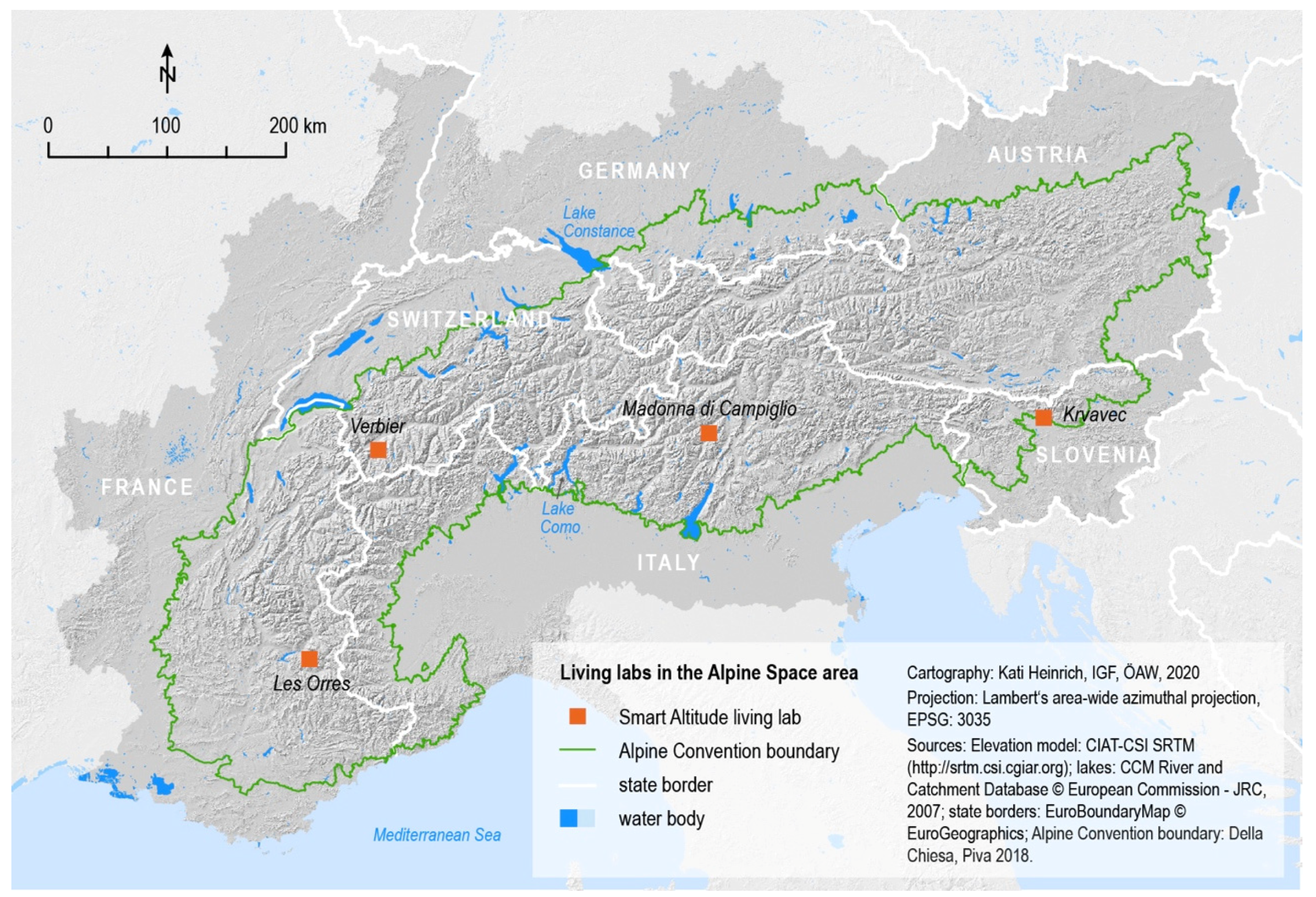
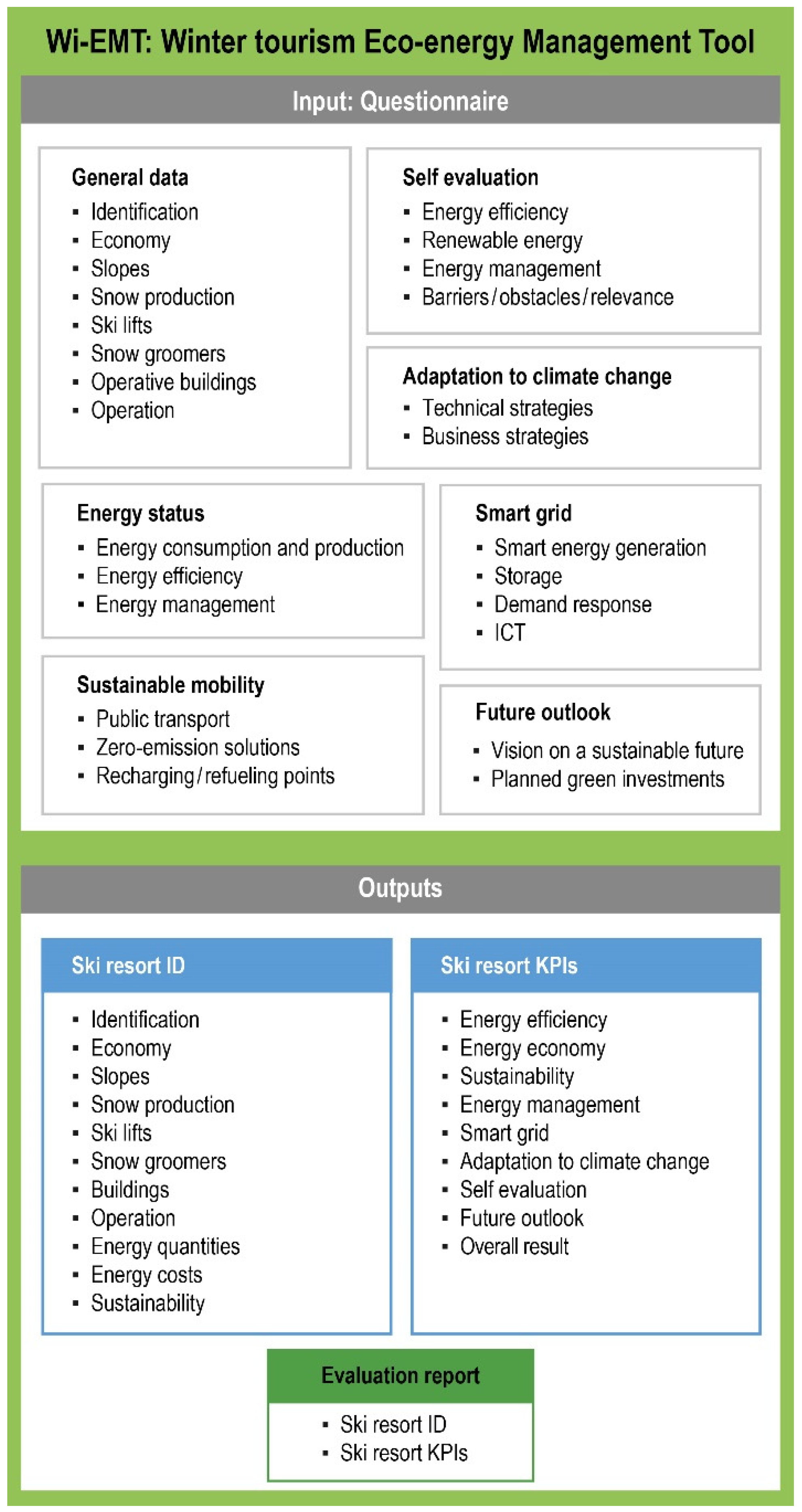
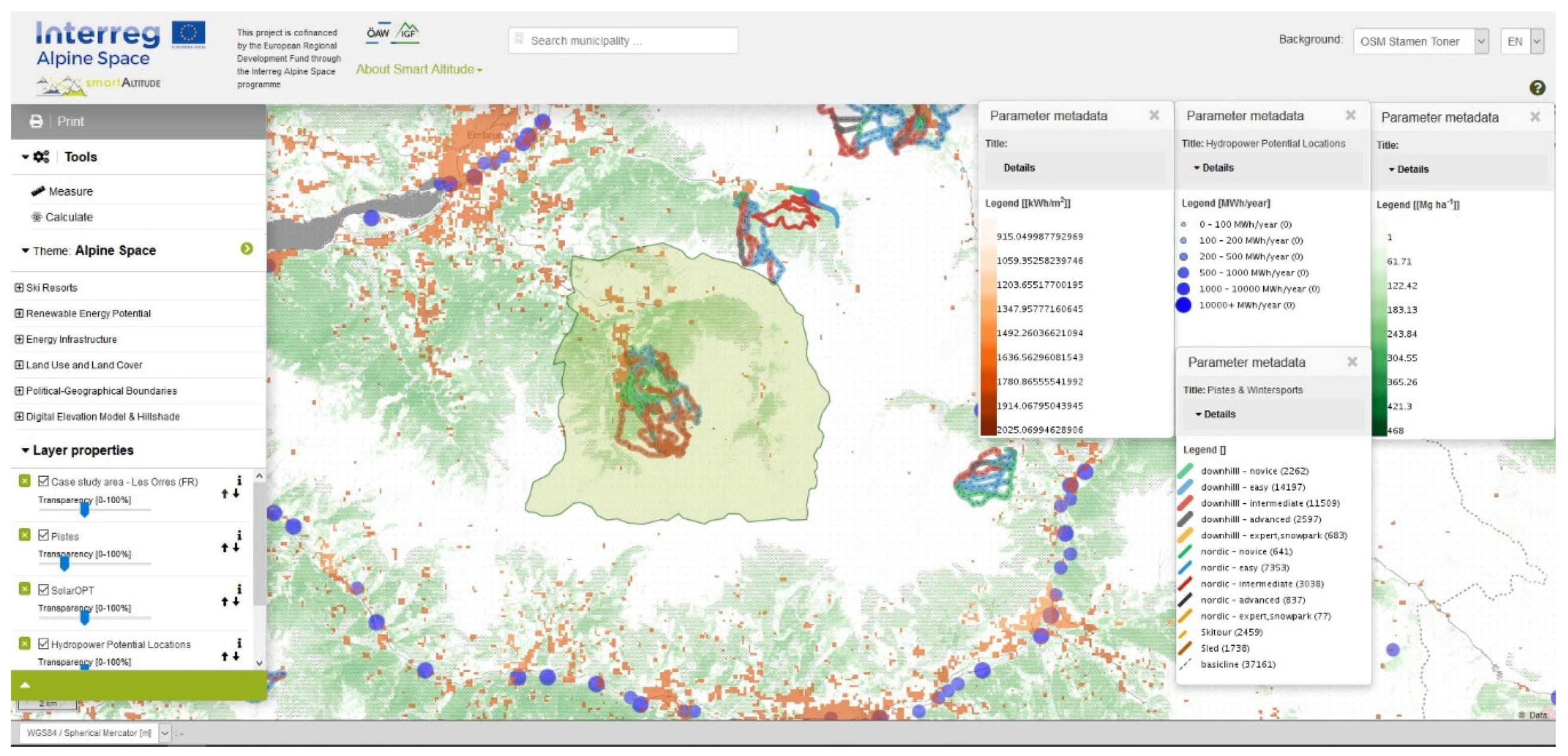
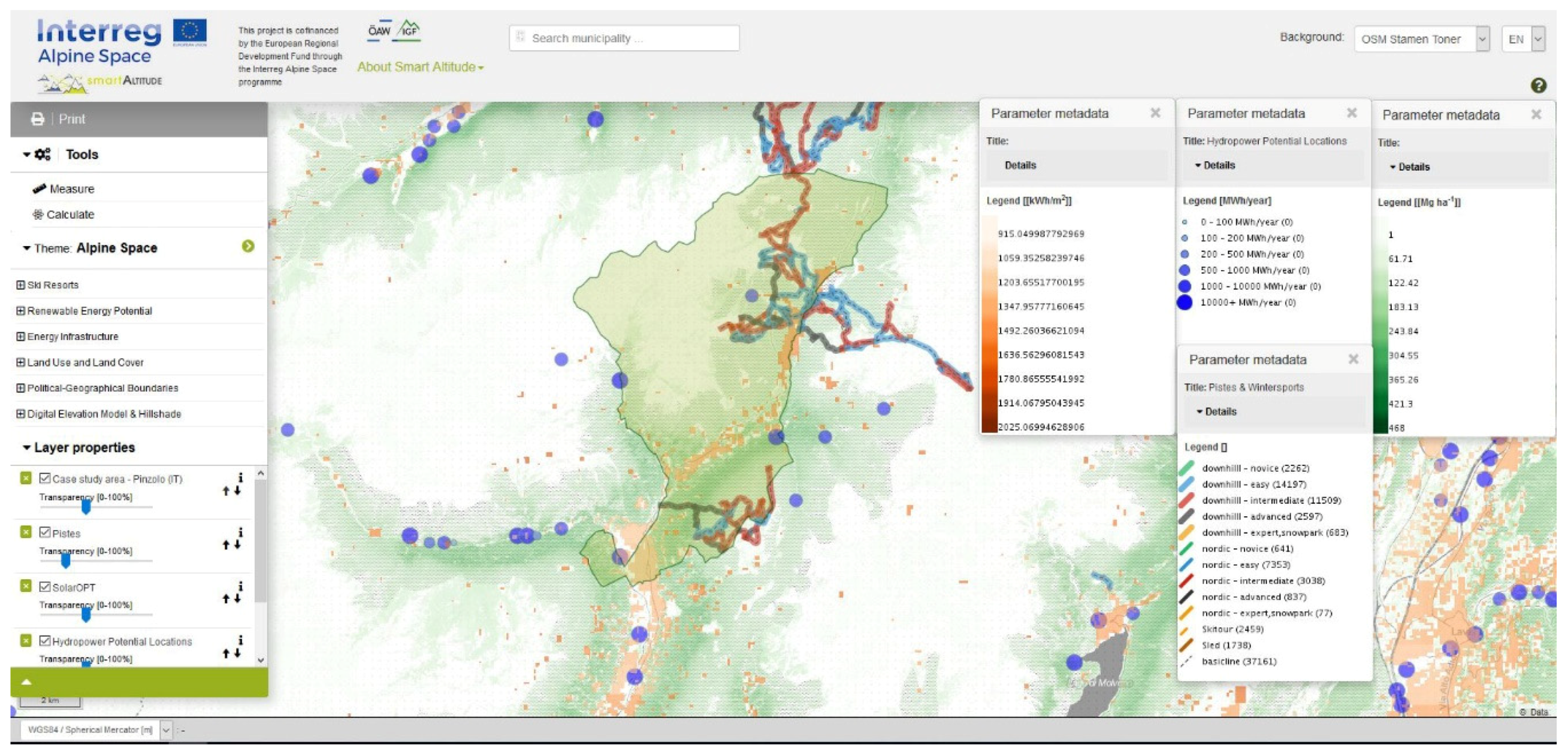
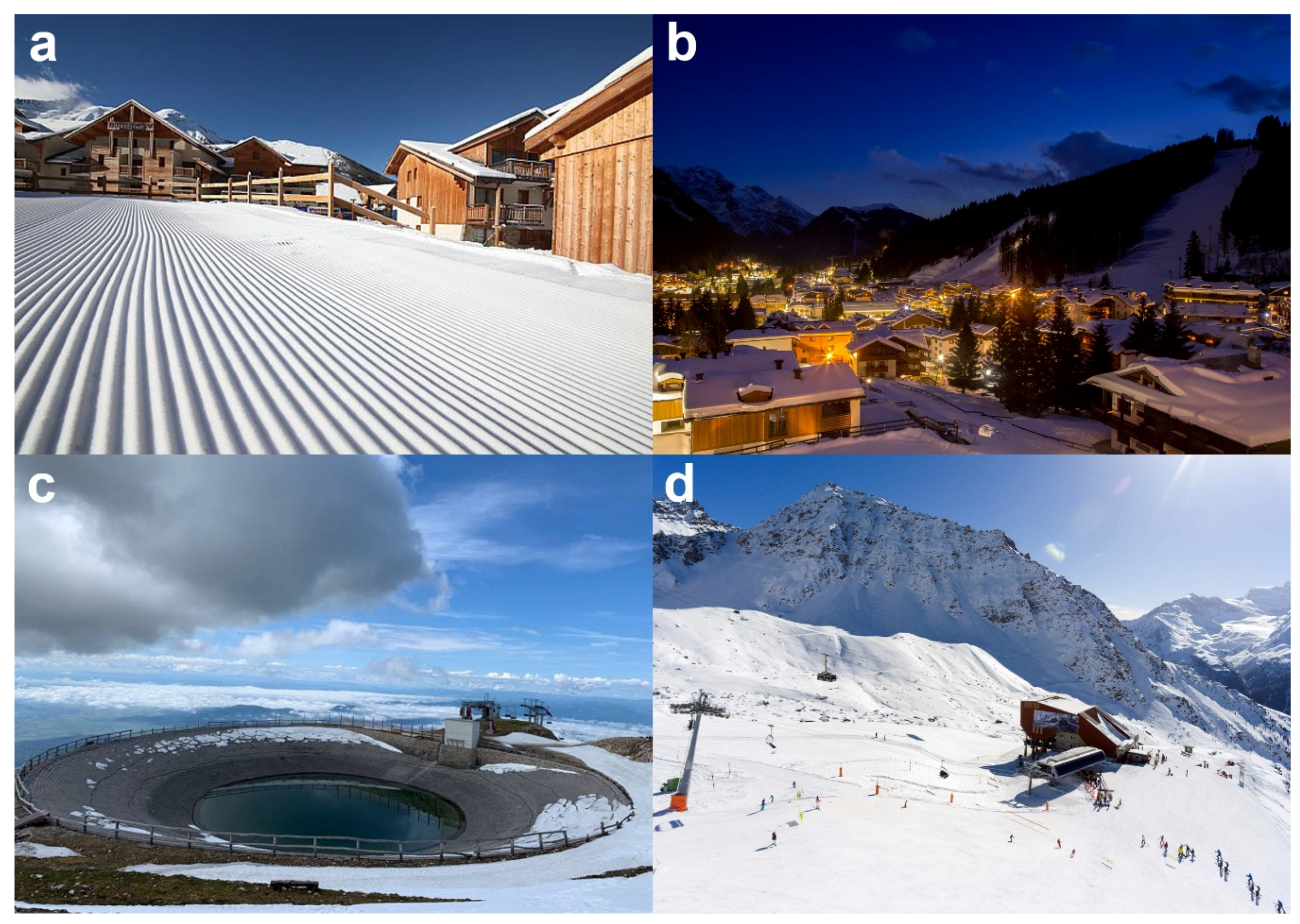
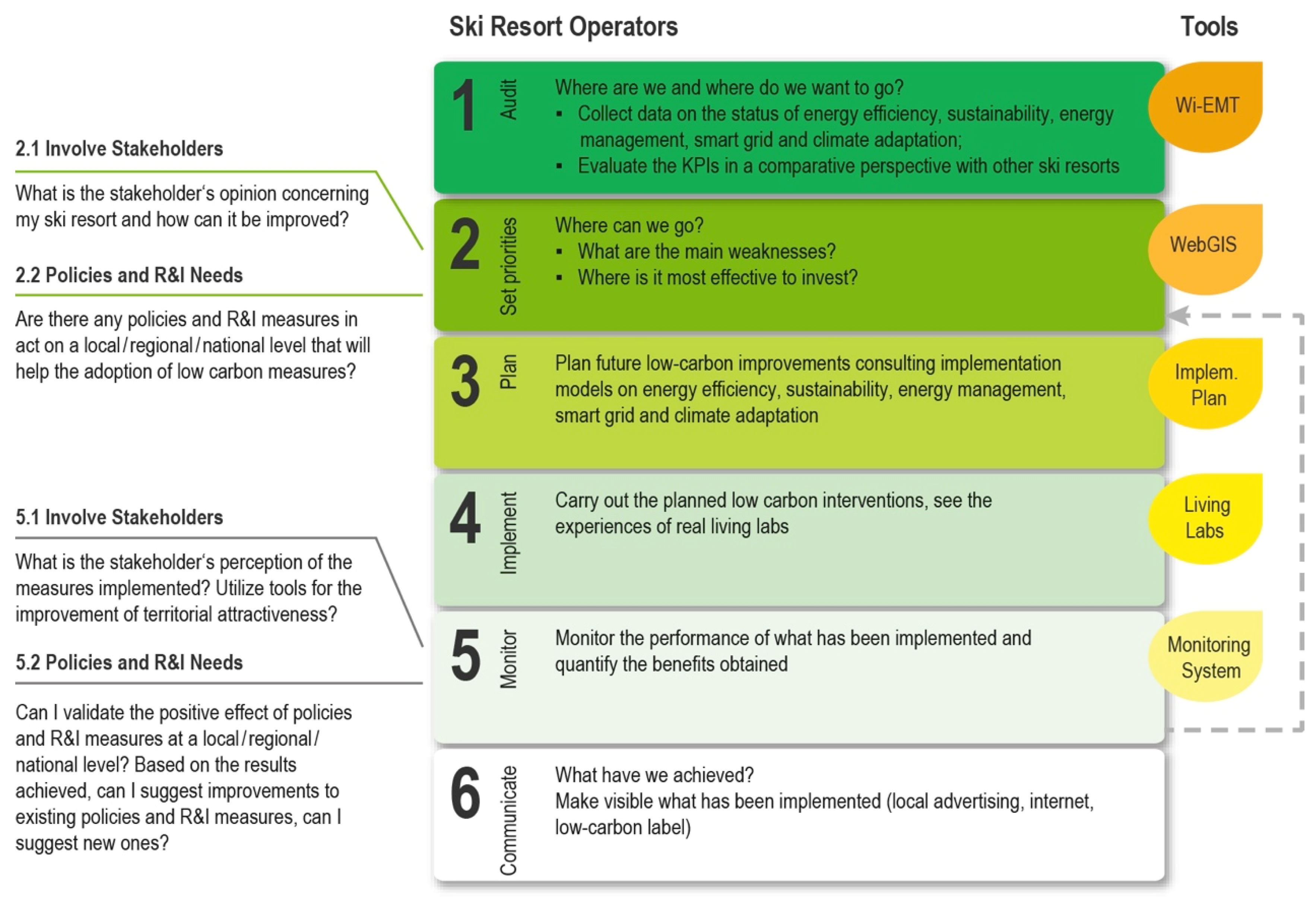
| Characteristic | Les Orres | Madonna di Campiglio | Krvavec | Verbier 3 |
|---|---|---|---|---|
| Municipality | Les Orres (FR) | Pinzolo (IT) | Cerklje na Gorenjskem (SI) | Bagnes (CH) |
| Ski Operator Company | SEMLORE SAEM | Funivie Madonna di Campiglio S.p.A | RTC Krvavec d.o.o | Téléverbier SA |
| Altitudinal range (m a.s.l.) | 1550–2720 | 1513–2501 | 1477–1973 | 1500–3300 |
| Construction of first lift (year) | 1966 | 1948 | 1973 | 1946 |
| Winter season turnover (EUR) | 11 million | 25 million | 4 million | 44 million |
| Skier days per winter season (count) | 510,000 | 1,222,872 | 205,508 | 1,161,554 |
| Ski slopes (km) | 48 | 60 | 30 | 200 |
| Lifts (km) | 15 | 28 | 13 | 43 |
| Lift capacity (persons per hour) | 22,398 | 35,533 | 14,121 | 45,980 |
| Snow guns (count) | 61 | 117 | 20 | 82 |
| Snow lances (count) | 125 | 629 | 90 | 278 |
| Snow production per winter season (m3) | 600,000 | 1,140,000 | 200,000 | 720,000 |
| Total energy consumption in winter season (kWh) 1 | 6,887,686 | 15,094,773 | 5,267,260 | 16,223,786 |
| Energy use for ski lifts (percentage of total energy use) | 23 | 22 | 15 | 37 |
| Energy use for snow production (percentage of total energy use) | 27 | 30 | 34 | 6 |
| Energy use for snow groomers (percentage of total energy use) | 27 | 24 | 23 | 34 |
| Energy use for operative buildings (percentage of total energy use) 2 | 23 | 24 | 28 | 23 |
| Renewable energy use (percentage of total energy use) | 12 | 30 | 16 | 56 |
© 2020 by the authors. Licensee MDPI, Basel, Switzerland. This article is an open access article distributed under the terms and conditions of the Creative Commons Attribution (CC BY) license (http://creativecommons.org/licenses/by/4.0/).
Share and Cite
Polderman, A.; Haller, A.; Viesi, D.; Tabin, X.; Sala, S.; Giorgi, A.; Darmayan, L.; Rager, J.; Vidovič, J.; Daragon, Q.; et al. How Can Ski Resorts Get Smart? Transdisciplinary Approaches to Sustainable Winter Tourism in the European Alps. Sustainability 2020, 12, 5593. https://doi.org/10.3390/su12145593
Polderman A, Haller A, Viesi D, Tabin X, Sala S, Giorgi A, Darmayan L, Rager J, Vidovič J, Daragon Q, et al. How Can Ski Resorts Get Smart? Transdisciplinary Approaches to Sustainable Winter Tourism in the European Alps. Sustainability. 2020; 12(14):5593. https://doi.org/10.3390/su12145593
Chicago/Turabian StylePolderman, Annemarie, Andreas Haller, Diego Viesi, Xavier Tabin, Stefano Sala, Annamaria Giorgi, Loïc Darmayan, Jakob Rager, Jelena Vidovič, Quentin Daragon, and et al. 2020. "How Can Ski Resorts Get Smart? Transdisciplinary Approaches to Sustainable Winter Tourism in the European Alps" Sustainability 12, no. 14: 5593. https://doi.org/10.3390/su12145593
APA StylePolderman, A., Haller, A., Viesi, D., Tabin, X., Sala, S., Giorgi, A., Darmayan, L., Rager, J., Vidovič, J., Daragon, Q., Verchère, Y., Zupan, U., Houbé, N., Heinrich, K., Bender, O., & Bidault, Y. (2020). How Can Ski Resorts Get Smart? Transdisciplinary Approaches to Sustainable Winter Tourism in the European Alps. Sustainability, 12(14), 5593. https://doi.org/10.3390/su12145593






